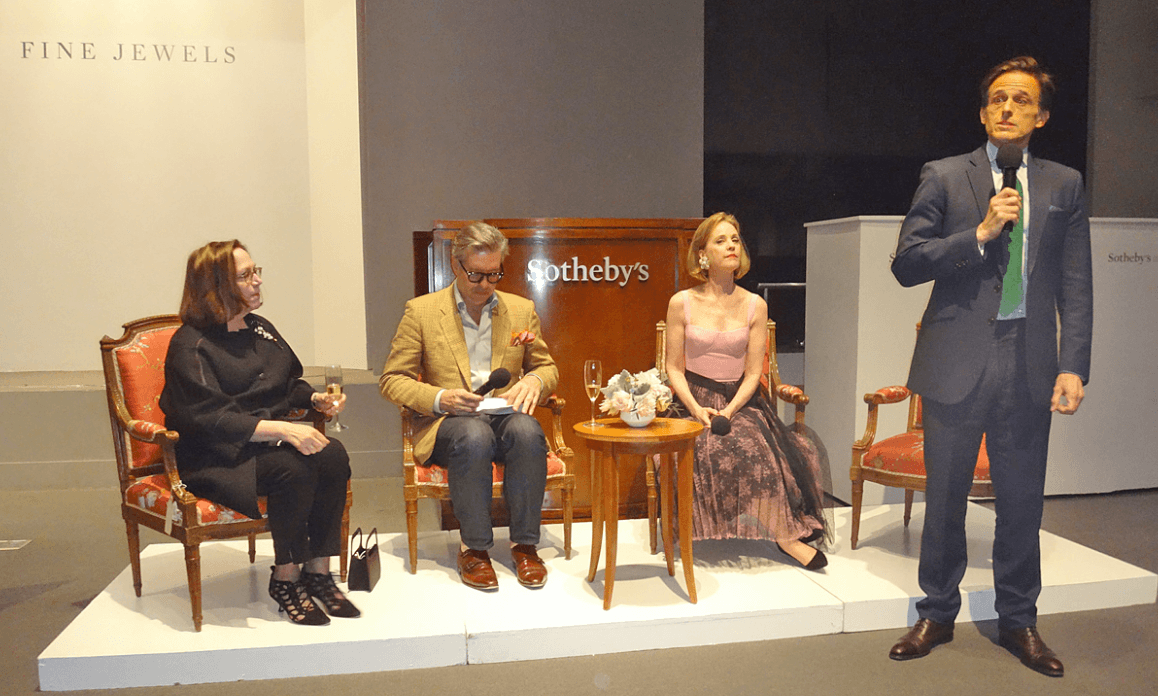 |
| Dior and His Decorators Book Cover More info/purchase Click images for full size views |
While examining the fashion and interior design history of Christian Dior is never a bad idea, this fall the French designer really seems to be trending. Not only is his “New Look” the jumping off point for the Philadelphia Museum of Art’s Fabulous Fashion exhibition, he’s hot in the world of furnishings as evidenced by a new book “Dior and His Decorators: Victor Grandpierre, Georges Geffroy, and the New Look,” by fashion historian/author and Francophile Maureen Footer. Of particular note for fashion fans: the book features a foreword by Hamish Bowles.
 |
| Left to right: Caroline Rennolds Milbank, Mitch Owens, Maureen Footer, Dennis Harrington |
I was fortunate enough to attend a panel discussion at Sotheby’s on Tuesday night featuring Footer; fashion historian and curator Caroline Rennolds Milbank; Decorative Arts Editor of Architectural Digest Mitchell Owens who served as moderator; and Vice President/Senior Specialist at Sotheby’s Dennis Harrington. Suffice it to say that even though my parents were avid collectors of French 18th century furniture and antiques –(Sotheby’s Saturday auction entitled “L’Art de Vivre: Property from the Collection of Kathleen and Martin Field,” features their high-end selections) which they lived amongst in their Main Line suburban Philadelphia home, I know precious little on the subject.
 |
| Audience Photo credit Laurel Marcus |
In an almost Monty Python-esque moment, Harrington opened the talk by informing the large audience in attendance that the upholstered chairs the panel was sitting comfortably in were Lot 1040 of the upcoming sale. An additional tie-in with Footer selecting her favorite pieces from the sale can be seen here.
 |
| Caroline Rennolds Milbank, Mitch Owens, Maureen Footer, Dennis Harrington (Photo credit BFA) |
The ensuing discussion centered on how the beginnings of the House of Dior was instrumental in recreating Post-war French style. “France has just come out of the war. Love, lives, and belongings have lost every bit of value,” said Owens. Footer agreed that “France had very little sense of hope or optimism when Christian Dior came on the scene.” Somehow he managed to shift their perspective, transitioning back to better times while still embracing modernity. “He supplied beauty when life had been so restricted, putting the richness back — tapping back into a great tradition. Dior reminded everyone of their heritage,” she explained.
 |
| Christian Dior Parfume Boutique in “Dior Gray” |
In the French tradition Dior hired two decorators for his Paris townhouse (usually one for the downstairs public spaces and one for the upstairs bedrooms). Grandpierre was a former fashion photographer and Geffroy (pronounced like the French phrase “J’ai froid” meaning “I’m cold”) a former fashion designer for Jean Patou. Summoned from his summer home in Cannes Grandpierre had only three months to complete the gut renovation on Dior’s salon at 30, Rue Montaigne. Legend has it that the paint was literally drying as Dior presented his first show. Grandpierre took a modernist approach incorporating stainless steel, track lighting, Louis XVI chairs and a touch of pink. He still has his stamp on the House of Dior through the identifiable “Dior Gray” walls with white plasterwork trim. (Benjamin Moore Dior Gray #2133-40). Even the template for the Dior brand — its typeface, logo, and packaging, are his creations.
Geffroy, a former silent film set designer had a flair for the dramatic mixing the classic with the modern to great effect particularly with textiles. A purist who would only take on one job at a time he worked with famous furniture designer Henri Samuel to decorate his home as well as in conjunction with Grandpierre on those of Gloria Guinness, Daisy Fellowes, Yves Saint Laurent, Marcel Rochas, and Maria Callas. Grandpierre and Dior, as well as to a lesser extent Geffroy shared a real fondness for the Belle Epoque, incorporating potted palms, winter gardens, woven rattan and tufted furniture in their designs.
The trinity of Dior, Grandpierre and Geffroy produced a “very modern sensibility, pared down and streamlined. Then they’ll have a judicious 18th-century chair mixed with a houndstooth pattern. There was a spirit of adventure as the world got smaller — rugs from Nepal, Nordic stoves, pre-Columbian statuary on a Riesener desk,” said Footer who wrapped up the panel portion of the evening by thanking Dior for all their support during her four years of research on this book.
 |
| Maureen Footer signing her book |
After the talk, cocktails and hors-d’oeuvres flowed on the fourth floor among the French and English furnishings and antiques. Footer’s book was available for purchase — a long line formed for those wishing to have their book signed so much so that the considerable stack eventually sold out. Even though this was my third time visiting Sotheby’s this week for various events and to view the displayed “rooms” it was still a bit surreal to have this event take place amongst my family’s soon to be sold collection. I made the best of it by giving mini-tours of my parent’s “house” to those who were interested, marveling to myself how even oft-seen items, much like acquaintances spotted out of their familiar context, are often hard to place.
– Laurel Marcus


